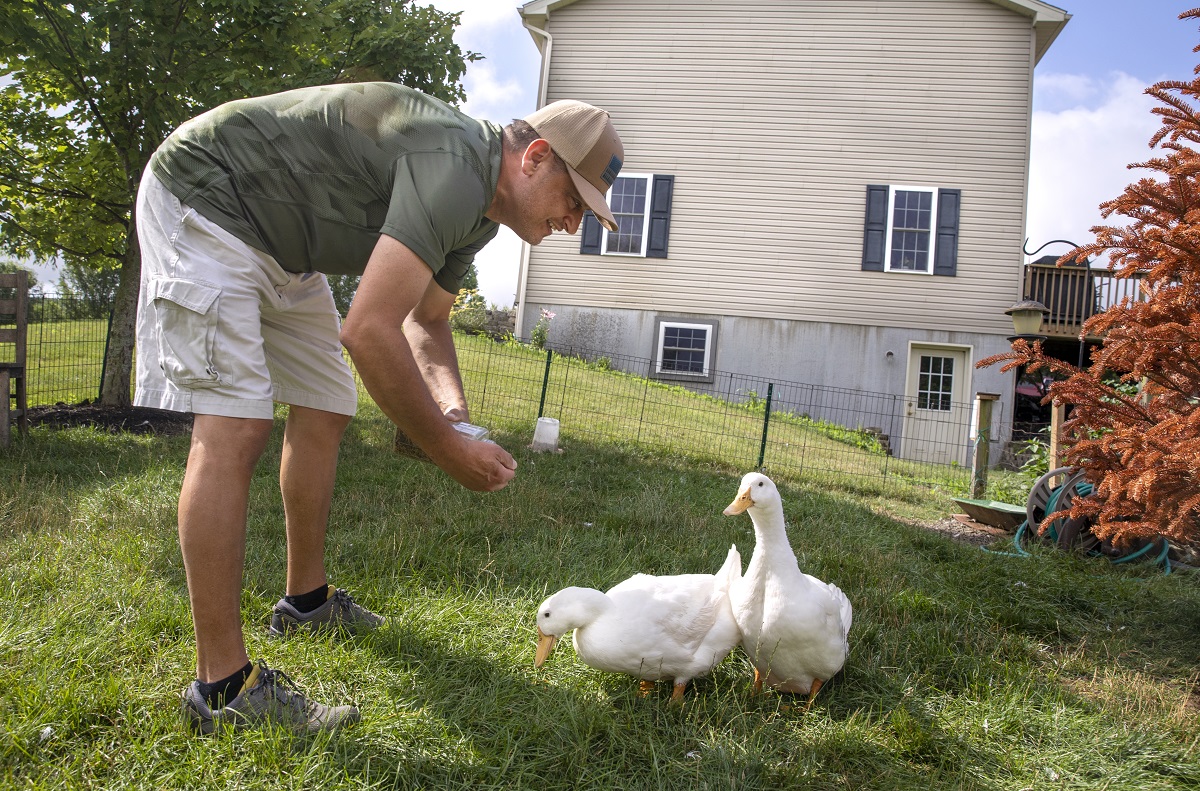Three-year heart transplant survival rate at Penn State Health Milton S. Hershey Medical Center tops national average

Whether he’s feeding ducks in his backyard or swimming in his newly built pool, Chris Frey takes a moment to appreciate how far he’s come since a series of near-fatal heart attacks almost five years ago.
“Most people don’t survive what I went through,” said Frey, 46, of Schuylkill Haven. “To make it where I am now is pretty amazing.”
Frey, who underwent successful heart transplant surgery in November 2017, is among hundreds of people who have thrived following the life-changing operation at Penn State Health Milton S. Hershey Medical Center. And a new report shows that patients who choose the Milton S. Hershey Medical Center for heart transplant experience better-than-expected survival rates a full three years after their transplant.
Data from the Scientific Registry of Transplant Recipients (SRTR) released in early July shows that 94.12% of heart transplant patients at Hershey Medical Center survive after three years. That’s nearly 10% higher than the national average three-year survival rate of 85.63%. The SRTR data includes transplants performed between July 1, 2015, and Dec. 31, 2017.
“The standard survival metric is at one year, and anything over 90% is regarded as excellent,” said heart transplant surgeon Dr. Behzad Soleimani with Hershey Medical Center. “So, for us to achieve 94% survival after three years is an outstanding achievement that’s a testament to the talent and spirit of everyone involved in the care of our patients.”
Frey knows what a difference a heart transplant has made in his life. His journey began in November 2016 when he suffered his first heart attack. “I had felt some chest pain, and I do have a history of heart problems in my family, but I thought at age 42 I was too young to have a heart attack,” he said.
While a cardiac catherization opened his blocked blood vessels, he didn’t respond to blood-thinning medication, and blood clots caused a second, more serious heart attack in the hospital. His heart stopped for 45 minutes, and he needed extracorporeal membrane oxygenation (ECMO)—a life-sustaining treatment that reoxygenated his blood—to survive.
To give him the best chance of recovery, doctors put Frey into a medically induced coma for two-and-a-half months. During that time, doctors also gave him a left ventricular assist device (LVAD), an internal electric pump that helps circulate oxygenated blood through the body. LVADs often serve as a bridge for heart transplant.
While Frey returned home in February 2017, he still needed an LVAD and suffered from additional health concerns—including kidney problems—that restricted his quality of life. “You can’t shower or swim with an LVAD,” he said.
During a follow-up appointment in August 2017, cardiologist Dr. David Silber, talked with other cardiologists at Penn State Heart and Vascular Institute, and then recommended Frey undergo a heart transplant. “He said either I continue the way I was, with a few good weeks and a few bad weeks, or we do a transplant and get your body right,” Frey said.
Now nearly four years after his heart transplant, Frey is enjoying the benefits of better health. He attends his 16-year-old twins’ sporting events, does woodworking projects in his garage, and hangs out with his wife, Kimberly, and their two dogs. “We’re going on vacation to Myrtle Beach this summer and hopefully in Aruba in the spring,” he said.
Frey’s dramatic recovery following heart transplant shows the benefit of the Heart and Vascular Institute’s team approach to care, Soleimani said. “Having a heart transplant program with surgeons, cardiologists, intensive care doctors, anesthesiologists, nurses and other disciplines working together allows us to collaborate, deliver thorough follow-up care and create better outcomes for our patients,” he said.
Frey’s story also speaks to the importance of having leading-edge heart care close to home. “People who need heart transplants require a lot of medical care before they even go on the transplant list,” Soleimani said. “It’s a huge advantage to patients in our community to know they can get the best heart transplant care right in their backyard.”
If you're having trouble accessing this content, or would like it in another format, please email Penn State Health Marketing & Communications.
